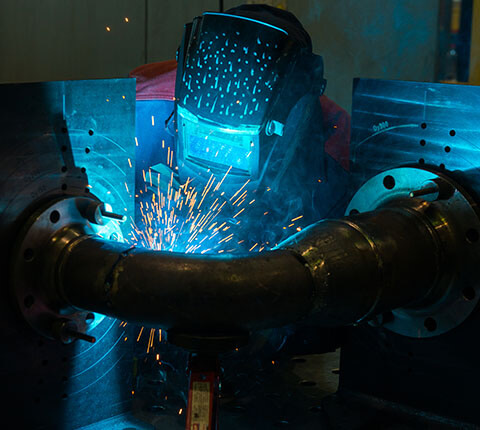Heat Exchangers
Heat exchangers are a critical component of many chemical process systems, and are used to transfer heat from one fluid to another. As a manufacturer of heat exchangers, we offer a variety of products to meet the needs of our clients.
Types of Heat Exchangers
One of our main offerings is the shell and tube heat exchanger. This type of heat exchanger consists of a shell, which contains a bundle of tubes. One fluid flows through the tubes, while the other flows through the shell around the tubes. This allows for efficient heat transfer between the two fluids.
We offer shell and tube heat exchangers with a range of tube types, including plain, corrugated, and finned tubes. Plain tubes are simple, smooth tubes that offer good heat transfer performance. Corrugated tubes have ridges on the surface, which can increase turbulence and improve heat transfer efficiency. Finned tubes have extended surfaces that increase the surface area available for heat transfer.
In addition to shell and tube heat exchangers, we also offer double pipe heat exchangers. These heat exchangers consist of two tubes, one inside the other, with one fluid flowing through the inner tube and the other flowing through the annular space between the two tubes. Double pipe heat exchangers are typically used for smaller applications where space is limited.
Our product line also includes reboilers and condensers. Reboilers are used to provide heat to a distillation column, while condensers are used to condense vapor into a liquid. Both of these products are critical components of distillation systems and play a key role in the separation of chemicals and the production of high-quality products.
Heat Exchanger Configurations
Our offerings include fixed tube, U-tube, and floating head tube types of heat exchangers, all of which are designed and fabricated in accordance with the ASME Boiler and Pressure Vessel Code (BPVC) Section VIII Division 1 and TEMA standards.
Fixed tube heat exchangers are a simple and cost-effective solution that is ideal for low-pressure and low-temperature applications. They consist of a set of tubes that are fixed in place within a shell, with the fluid flowing through the tubes and the shell side acting as a heat transfer medium.
U-tube heat exchangers, on the other hand, are ideal for high-pressure and high-temperature applications. They consist of a set of U-shaped tubes that are connected to a tube sheet at each end, with the fluid flowing through the tubes and the shell side acting as a heat transfer medium. U-tube heat exchangers are designed to allow for thermal expansion and contraction, which helps to reduce stress on the tubes and tube sheets.
Floating head tube heat exchangers are a versatile option that is suitable for a wide range of applications. They consist of a set of tubes that are fixed at one end and attached to a floating head at the other end, with the fluid flowing through the tubes and the shell side acting as a heat transfer medium. Floating head tube heat exchangers are designed to allow for thermal expansion and contraction, which helps to reduce stress on the tubes and tube sheets, and they also allow for easy access for maintenance and cleaning.
All of our heat exchangers are designed and fabricated to meet the rigorous standards set forth by the ASME BPVC Section VIII Division 1 and TEMA standards. This ensures that our heat exchangers are safe, reliable, and built to last. We also offer a range of customization options to meet the specific needs of each project, including different materials, sizes, and configurations.
Tube to Tubesheet Joints
Tube-to-tubesheet joints are a critical component of shell-and-tube heat exchangers, and the joint must be able to withstand the pressure and temperature requirements of the application. There are two primary methods for creating tube-to-tubesheet joints: welding and expansion.
Welding involves melting and fusing the tube and tubesheet together using heat and pressure, creating a strong bond. Welded joints are typically used in high-pressure and high-temperature applications, as they are able to withstand the stresses and strains that these conditions can create.
Expansion, on the other hand, involves mechanically expanding the tube into the tubesheet, creating a tight and secure fit. This method is typically used in low-pressure and low-temperature applications, as it is not as strong as a welded joint. However, expansion is often preferred in applications where thermal expansion and contraction may cause issues with a welded joint.
At our company, we have qualified procedures for both welding and expansion, and in some cases, we use a combination of both methods to create a hybrid joint that provides the benefits of both.
Our welding procedures have been rigorously tested and qualified to ensure that they meet the highest standards for safety, quality, and performance.
Similarly, our tube expansion procedures have also been qualified to ensure that they create a tight, secure fit that can withstand the stresses of the application. We use a range of expansion techniques, including hydraulic expansion and mechanical expansion, depending on the specific requirements of the project.
By offering both welding and expansion methods, as well as hybrid joints that combine the benefits of both methods, we are able to provide our clients with the optimal solution for their specific application. Our qualified procedures and expert technicians ensure that each joint is created to the highest standards of safety, quality, and performance, and we are committed to providing our clients with the best possible solution for their tube-to-tubesheet joint requirements.
As a manufacturer of heat exchangers, we have extensive experience in fabricating high-quality products that meet the specific needs of your clients. One of your notable achievements is the fabrication of heat exchangers with a surface area of up to 295 square meters, all made from SS316L material.
By successfully manufacturing heat exchangers of this size and material, we have demonstrated your ability to meet the unique needs of your clients and provide them with the high-quality products they require. Your expertise in this area is invaluable to the chemical processing industry and plays a key role in ensuring the safety and efficiency of many chemical processes.



